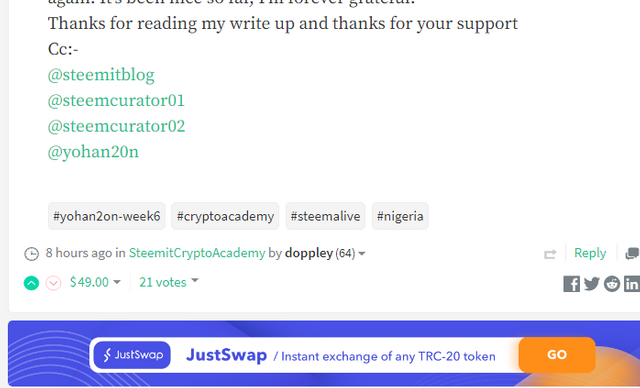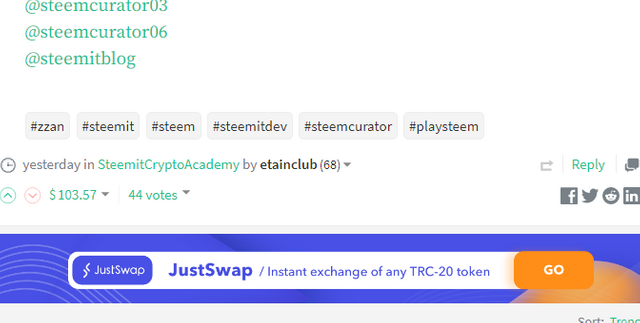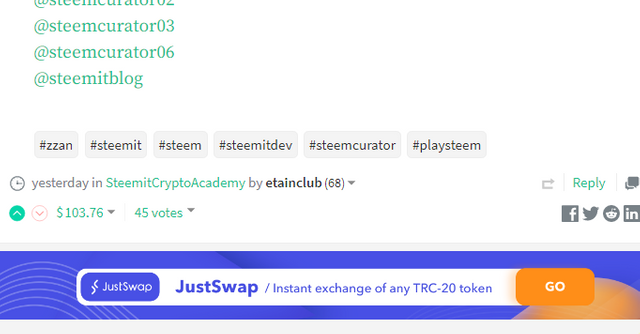
(1) What are the economic & social ramifications of self-upvote in Steem Blockchain? Do you gain better curation rewards by upvoting others as compared to self-upvote? (Include real examples)
Prior to the emergence of Convergent Linear Reward system, self-upvoting was profitable especially to those big weights in steemit . It increases the daily potential earning value of the one who engages in such conduct. For instance, one whose voting value is $17 had as others do, a 10 chance of voting. If he self-upvote himself ten times daily, he makes a whooping sum of $170 just in one day. This conduct was abusing the reward pool since it made rich only the rich. Was there any striking balance of self-upvoting on social effects to the less privilege steemit users? No. It's unethical, it was very discouraging. The self-upvoter knowing he will make the lion share should a whale voted after him, was selfish rather than considerate of other users. Self-upvoting creates an arena of posting blunders or jargon, empty posts lacking message but are pushed to the top to trend and get high votes. It led to poor content discovery instead of quality content discovery. Steemit as a social platform has the objective to pass knowledge and fun among users but with self-upvoting, this objective is lost.
As per whether I gain better curation reward upvoting others instead of the other way, I answer a resounding yes. This become possible with Convergent Linear Reward system which have pushed down the earning potential of self-upvote the lowest minimal. Moreso, curation has a long term benefits because it pushes up the market value of steem on the blockchain whereas the other action devalues the steem blockchain. Also when the market value of steem goes high, many newcomers will get on board resulting to more quality content, more global acceptability, more investors. Personally, I want this platform to last longer than usual, and better quality content leads to better curation.
Furthermore, upvoting other peoples' post early enough when the voting window is opened keeps me in a position to earn more. What I usually do is targeting new posts, allowing five minutes to pass and hitting my upvote icon, then I can make up to 400% or even 600% of my voting weight.

(2) What is the difference between isolated judgment and community judgment in curation? Put simply, isolated judgment relates to an individual upvote value to a publication. A single curator who locates a quality post alone gets lower reward, he is said to be an isolated judgment, he decides which publication is qualitative and upvotes on his own. His reward from that post is often lower even if a whale should vote after him. But a community judgment relates to multiple curators who agreed on same publication as the isolated judgment did, but because the judgment reached was based on multiple ideas, the reward arising from such curation is often higher. So the difference is on the result or output of the curation.
How do you adapt to community judgment on quality content in Steem Blockchain? Does that bring economic incentive for you? Delegation is one way to adapt to community judgment. This means pooling together multiple Steem Power to one account then upvoting a quality content publication to achieve higher output. Another way is to join a curation trail and upvoting with that account, it yields higher value whether a whale votes after or not, in as much as the post is trending.
If yes, explain with real examples, (include screenshots and compare them with your isolated judgment)?
Yes there is always an economic incentive for me when an account delegated with much SP upvotes a particular post which I too curated, I earn more than when I isolate my upvote. The following example of such account with a pool of liquidity explains the positive results.

(3) Go to Steemworld.org, check your Upvote value( at the current SP, VP). Take a screenshot.
The screenshot below shows my voting full weight at 0.01
Then go to the Steemit trending page, find a post with a payout of more than $10 but less than $50(Age less than 6 Days 12 hrs). Upvote it. Take screenshots before and after upvote.
This was before I upvote the post.

This was after upvoting the post
Similarly, go to another post on the Trending page, find a post with a payout of more than $100( Age less than 6 Days 12 Hrs). Upvote it. Take screenshots before and after upvote.
The post before upvoting.

After upvoting the post.
Tell the differences between the two. Which one has produced a greater Upvote value & Curation reward for you with the same resources(SP, VP)?
With the same voting power of 0.01, the first upvote was cast on isolated judgment on a post lower than $50 resulting in a reward of 0.3 whereas the second deal with same vote amount on a post of more than $100 rewarded me with 0.19. The difference is clear - $0.11 almost 4 times over.
Explain? From the results shown above, upvote on an isolated judgment will always generate lower reward, it is a lonely deal but when isolated judgement transform to community judgement because there's an agreement and a pool of SP, the rewards become linear, it generates higher curation reward.
Thank you once again @sapwood for this training. I hope this will be rated accordingly.
@steemcurator01
@steemcurator02
@stephenkendel
@cryptokannon
@bright-obias
@focusnow
@ngoenyi






